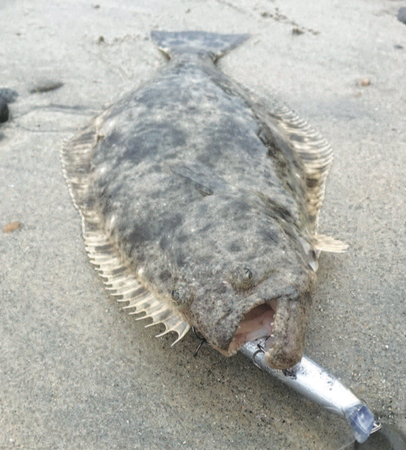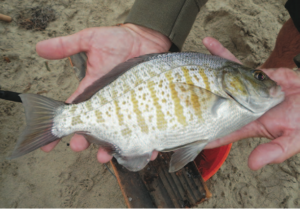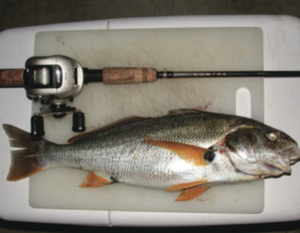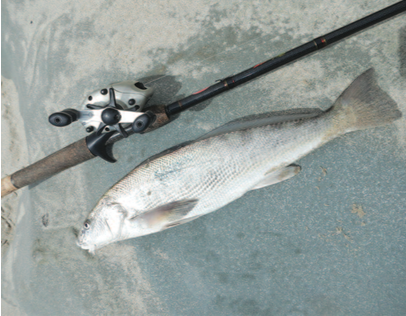
BY TIM HOVEY
A few years ago, I decided to go through one of my fish identification books and see how many of the listed California coastal species I had caught during my time as a fisherman. After a careful search of photos and my memory, I tallied almost 150 different fresh and saltwater species in a lifetime of fishing.
Despite my fisheries science background, I’ve always known that the reason I pursued this career was because I am a diehard fisherman. And at the root of that interest is the desire to catch as many different species as I can.
When it comes to fishing, I’ve always been into variety. I certainly have my favorite species I enjoy catching, but I’d much rather spend a day fishing for whatever decides to bite best. When it comes to catching different species and ease of access, I head to the sandy coast.

I grew up fishing the shores near Santa Barbara and to be honest, I honed my fishing skills barefoot and with sand under my feet. After college, I moved to the San Diego area and I spent many years fishing the shores there and catching everything from perch to sharks. I later relocated and started fishing the shores near Ventura. To me, there’s nothing better than fishing the shore and wondering what you’ll catch.
Throughout my surf fishing career, I’ve caught most of the regular species, some unique species and a handful of fish that I wasn’t able to stop. I’ve used everything from large, 15-foot casting rods to ultra-light gear, and honestly, I’ve loved every minute of it.
When it came to larger species, I will say that I encountered far more bat rays, six gills and smooth hound sharks off the coast of San Diego. Having explored the habitat down there through diving, I can say that the near-shore environment down there is a lot more diverse and will hold a higher variety of fish species than one might think.
Moving north you encounter a lot more near-shore, sandy environments, which still hold a wide variety of fish, but in my experience the larger species travel closer to shore in the south.
Fishing with my good friend, Eric Frandsen, we were soaking whole squid on surf rods at night at the San Diego shore. Using sand spikes and lanterns, the goal was to land something huge. After an hour of short bites with no hook-ups, something grabbed my bait and took off. I set the hook and instantly realized I wasn’t equipped to stop whatever was at the end of my line.
We initially thought it was a bat ray, but it wasn’t fighting like a ray. This beast just swam straight offshore and didn’t even seem to notice it was hooked. I also felt something hit the line consistently as the unseen fish pulled drag. To me, this told me it was the tail of whatever I had hooked.
Over the next 30 minutes, I did my best to gain line on the unseen fish, but it was clear I was undergunned. Then after a quick run, he broke off. Thankfully, I only lost a few feet of line. When I reeled in, the end of the line was heavily frayed. I will never forget that late-night beach fight.
When I moved north, I started fishing lighter tackle for the near-shore species. This certainly could be the reason I haven’t hooked into larger species to the north. However, having explored both areas during dives, I can say that the two habitats are definitely different.
Despite the varied species diversity, I can say that the beaches to the north hold a special place in my heart for me. Off the coast of Goleta, Santa Barbara and Ventura is where I taught my daughters how to fish. Using a simple Carolina rig and the Berkley Sandworms, my family was able to practice casting, hook setting and fighting fish at these popular Southern California beaches.

We spent many summers catching barred surfperch, walleye surfperch, spotfin croaker, yellowfin croaker, corbina, halibut, small leopard sharks and bat rays at the shore. At the beach is where they were shown the diversity of fish species they could catch in only a few feet of water. The challenge that is needed to land a fish in a constantly changing surf condition made my daughters better, more balanced anglers.
When I don’t have the time or opportunity to fish offshore in a boat, I can always toss a couple of light tackle rods in the truck and head down to the shore. The ease of access and the species diversity is what keeps me coming back. There’s just something about slow walking the shore barefoot that just brings me back to my childhood and how I started fishing. Working a lure or sand crab just behind the breakers and wondering what will bite is the basic thrill that drives all anglers. With the temperatures warming, it’s time to toss a few rods in the truck and head to the beach. I wonder what’s biting!




